Square dancing is a vibrant and joyful activity that combines social interaction, physical exercise, and mental stimulation. One of the delightful aspects of square dancing is the opportunity to express your personal style through your attire. Whether you’re just starting out or preparing for a grand convention, understanding the nuances of Square Dance Apparel can enhance your experience. This guide will walk you through everything you need to know about dressing for square dancing, from beginner classes to formal events.
Comfortable Beginnings: Casual Wear for Classes
When you’re first dipping your toes into the world of square dancing with beginner classes, comfort is key. The focus is on learning the steps and enjoying the movement, so your clothing should facilitate ease and flexibility.
Think of comfortable, everyday clothes that allow for a full range of motion. For both men and women, suitable options include:
- Pants: Jeans, chinos, or comfortable trousers are excellent choices. For warmer seasons, shorts or capri pants are also appropriate, ensuring they are not too restrictive.
- Tops: T-shirts, polo shirts, and casual blouses are ideal. Breathable fabrics are recommended to keep you cool as you learn the dances.
- Skirts: For women who prefer skirts, choose styles that allow for easy movement. A-line skirts or those with a comfortable flare are perfect. Avoid anything too tight or restrictive.
- Shoes: Sneakers, walking shoes, or other closed-toe, comfortable shoes are essential. Safety is paramount, so ensure your shoes are supportive and allow you to move freely without slipping. High heels or open-toed shoes are not recommended for beginner classes.
 Beginners in comfortable square dance attire
Beginners in comfortable square dance attire
Image: Beginners dressed in comfortable and casual square dance apparel, ready for their first class.
Regular Square Dances: Finding Your Style
As you progress to regular square dance events, you’ll notice a wider variety of attire. This is where personal style starts to shine, and you can choose to dress up a bit more or maintain a comfortable, relaxed approach.
For women at regular dances, options expand to include:
- Jeans or Dress Pants: Still a comfortable and popular choice, especially for casual dances.
- Flowing Tops or Blouses: Tops with a bit more flair, perhaps with ruffles or interesting sleeves, add a touch of elegance while still allowing for movement.
- Simple Skirts: Skirts become more common at regular dances. These can range from simple, comfortable skirts to modern square dance skirts.
- Modern Square Dance Outfits: These outfits are designed specifically for square dancing and often feature comfortable, flowing skirts and tops.
- Traditional Outfits (with light petticoats): Some dancers enjoy the classic look of traditional square dance dresses with petticoats, though lighter petticoats are more common for regular dances than the fuller ones seen at conventions.
- Closed-toe Shoes: Still recommended for safety, but you might opt for dance shoes or more stylish closed-toe shoes.
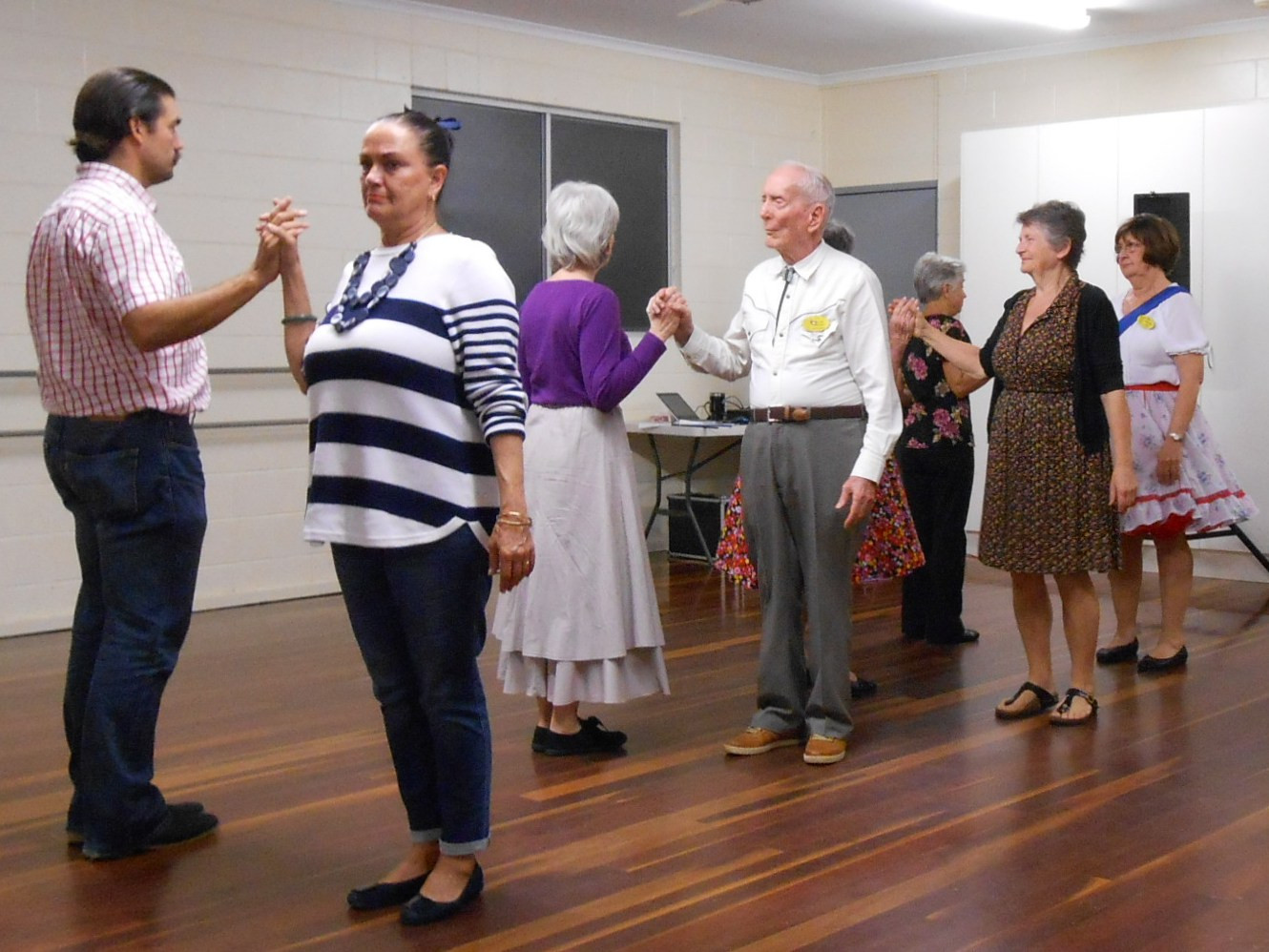 Ladies in various styles of square dance apparel at a regular dance
Ladies in various styles of square dance apparel at a regular dance
Image: A group of women showcasing diverse square dance apparel styles at a regular Friday night dance.
 Another view of ladies at a regular square dance in stylish outfits
Another view of ladies at a regular square dance in stylish outfits
Image: Close-up of women’s square dance outfits, displaying a range of skirts and tops suitable for regular dances.
For men at regular dances, acceptable attire includes:
- Jeans or Dress Pants: Similar to women, jeans or dress pants are versatile options.
- T-shirts, Polo Shirts, or Long Sleeve Shirts: Choose from casual T-shirts to slightly dressier polo shirts or button-down long sleeve shirts.
- Traditional Shirts (optional): Some men opt for traditional square dance shirts, which may feature embroidery or western-style details.
 Men showcasing different styles of square dance shirts and pants
Men showcasing different styles of square dance shirts and pants
Image: Men in varied square dance apparel, including jeans, polo shirts, and traditional western-style shirts.
Accessories for Men:
- Scarves and Bolo Ties: A popular accessory for men is a small scarf held by a ring or a bolo tie, which is a decorative string tie with a clasp.
Convention and Formal Dance Apparel: Stepping Up the Style
State and National Square Dance Conventions are grand events that attract large numbers of dancers and call for a more formal dress code. These events are a chance to truly embrace the tradition and elegance of square dance apparel.
General Convention Dress Code Elements:
- Formal Attire: Conventions generally require more formal attire than regular dances.
- Dress Codes Vary: While national guidelines exist, individual state conventions may have slight variations in their dress codes. Always check the specific dress code for the convention you are attending.
- National Dress Code (Example – Australian): It’s helpful to review national dress codes to understand the general expectations for formal square dance events. (A link to an example dress code is provided in the original text).
Men’s Convention Apparel:
- Trousers, Slacks, or Dress Jeans: Neat and tidy trousers, slacks, or dress-type jeans are required.
- Dress Shorts (with conditions): Dress shorts may be permitted but often only when worn with long roll-top socks, maintaining a level of formality.
- Buttoned, Full-Sleeve Shirts: Shirts must be buttoned and have full-length sleeves, contributing to a more formal appearance.
- Bolo Ties, Cravats, or Scarves: These accessories are essential to complete the formal men’s square dance look.
- Dress Shoes or Dance Boots: Clean dress shoes or dance boots that won’t mark the dance floor are mandatory.
- Hats (indoors – restricted): Hats are generally not worn indoors unless part of a themed event or demonstration.
 Dancers at a convention, demonstrating formal square dance dress code
Dancers at a convention, demonstrating formal square dance dress code
Image: Convention attendees dressed in formal square dance apparel, adhering to dress code guidelines.
Women’s Convention Apparel:
- Square Dance Dress or Skirt: Ladies are required to wear a square dance dress or skirt.
- Petticoats (Common): While not always explicitly mandated in every dress code, petticoats are very commonly worn to give skirts the desired fullness and shape.
- Appropriate Underwear: Discreet underwear suitable for dance attire is expected.
- Acceptable Tops: Tops can be long or short-sleeved blouses, with short sleeves covering the shoulders being the most common.
- Restrictions: Full backless, bare back, or bare midriff styles are not considered acceptable for convention dress codes.
- Western/Prairie Skirts (Less Common at Conventions): While longer western or prairie skirts are options, they are less frequently seen at conventions, where knee-length full circle skirts are more traditional.
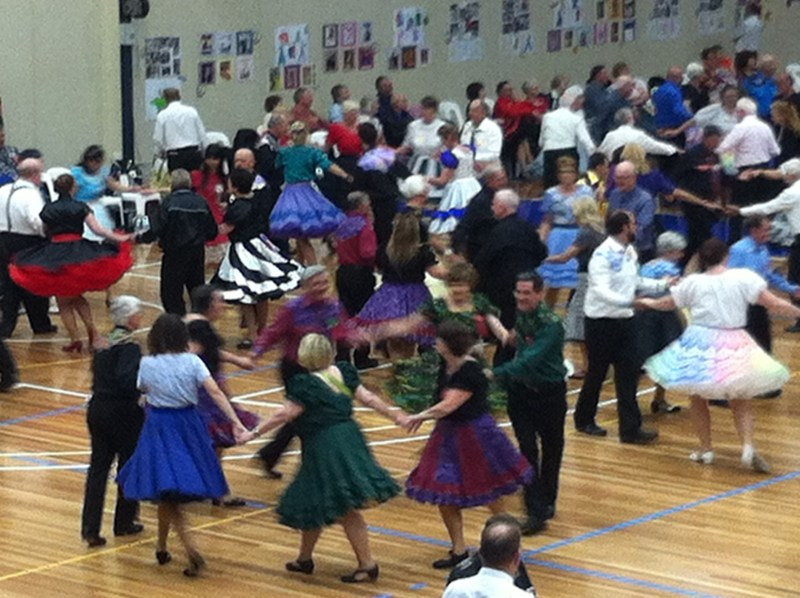 Petticoats, a key element of traditional women's square dance apparel
Petticoats, a key element of traditional women's square dance apparel
Image: A display of petticoats, highlighting their importance in achieving the classic square dance skirt silhouette.
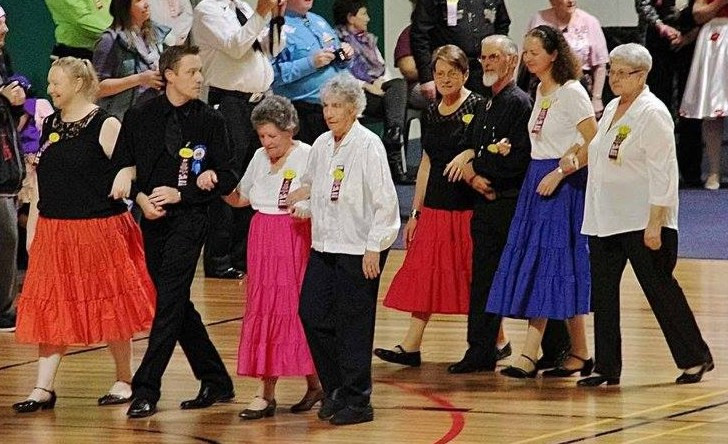 Ladies in formal square dance dresses at a convention
Ladies in formal square dance dresses at a convention
Image: Women at a convention wearing traditional square dance dresses, showcasing the expected formal attire.
Alternative Styles for Women:
- Western/Prairie Skirts: For those who prefer longer skirts, western or prairie skirts are alternatives to the standard knee-length circle skirts.
- Men’s Style Apparel (for left-hand dancers): Some women who dance the man’s part (left-hand dancer) may choose to wear men’s style clothing, such as trousers and button-down shirts. However, even in this role, many women still prefer traditional ladies’ outfits.
- Sashes: Ladies dancing the left-hand position may wear a sash, often blue, to indicate their role to other dancers and the caller.
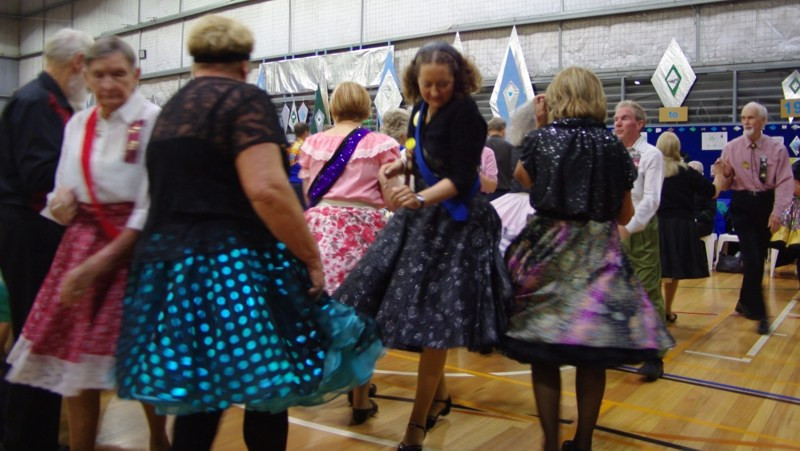 A lady wearing a sash to indicate left-hand dancing position
A lady wearing a sash to indicate left-hand dancing position
Image: A woman wearing a sash, a common indicator for ladies dancing the left-hand position in square dancing.
Shoes and Accessories for Women:
- Dance Shoes or Jiffies: Clean, low-heeled or flat-heeled dance shoes or “jiffies” (soft dance shoes) are required. Shoes must not mark or damage the floor.
- Heel Restrictions: Spike heels or very small heels are typically prohibited. Heels must meet minimum length requirements for floor contact (e.g., 25mm).
- Closed-toe Shoes (Recommended for safety): While not always mandated in dress codes, closed-toe shoes are strongly recommended for safety, especially in crowded convention settings.
- Jewelry: Jewelry should be snag-free to prevent damage to clothing during dances.
Modern Trends and Variations in Square Dance Apparel
Square dance apparel is not static; it evolves with fashion trends and dancer preferences. Modern square dance attire embraces variety while still respecting the traditions of the dance.
Modern Petticoats:
- Light to Medium Fullness: Modern petticoats are often softer and less bulky than older, very full styles.
- 50s and Vintage Styles: Petticoats and skirts inspired by the 1950s, vintage fashion, and Rock and Roll styles are increasingly popular in square dance outfits.
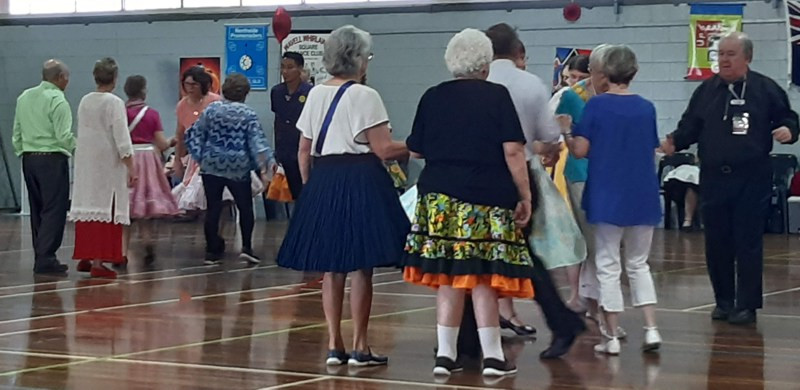 Modern petticoats, showing different styles and fullness
Modern petticoats, showing different styles and fullness
Image: A comparison of older, fuller petticoats with modern, lighter styles, showcasing the evolution in petticoat design.
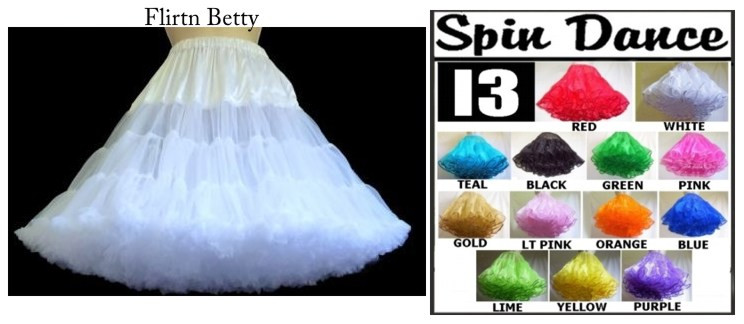 Modern petticoats designed for movement and style
Modern petticoats designed for movement and style
Image: Modern square dance petticoats that provide body and allow for a horizontal line effect during spins.
Undergarments for Modesty:
- Slips, Leggings, or Pettipants: For modesty under petticoats, dancers may wear slips, short leggings, or pettipants (frilly dance shorts).
 Pettipants, a practical and modest undergarment for square dancing
Pettipants, a practical and modest undergarment for square dancing
Image: Pettipants, designed for modesty and comfort under square dance skirts and petticoats.
Tops for Women:
- Varied Styles: Ladies’ short sleeve shirts come in a wide range of styles and don’t necessarily need to be specifically designed for square dancing.
- Peasant Shirts (Modernized): Peasant-style shirts remain popular, but modern versions often feature less exaggerated sleeves and frills compared to traditional styles.
- Bubble Shirts: Bubble shirts are gaining popularity, known for their comfort, stretch, and ease of packing and care.
- Pleated Skirts: Soft, pleated skirts are also favored for conventions due to their packability and wash-and-wear convenience.
Traditional vs. Modern – Personal Choice:
- Traditional Styles Still Welcome: While modern styles are prevalent, traditional square dance outfits, including frilly peasant tops and matching skirts, are still worn and appreciated, especially at larger events.
- Personal Preference: Ultimately, your choice of square dance apparel comes down to personal preference, comfort, and the specific event’s dress code.
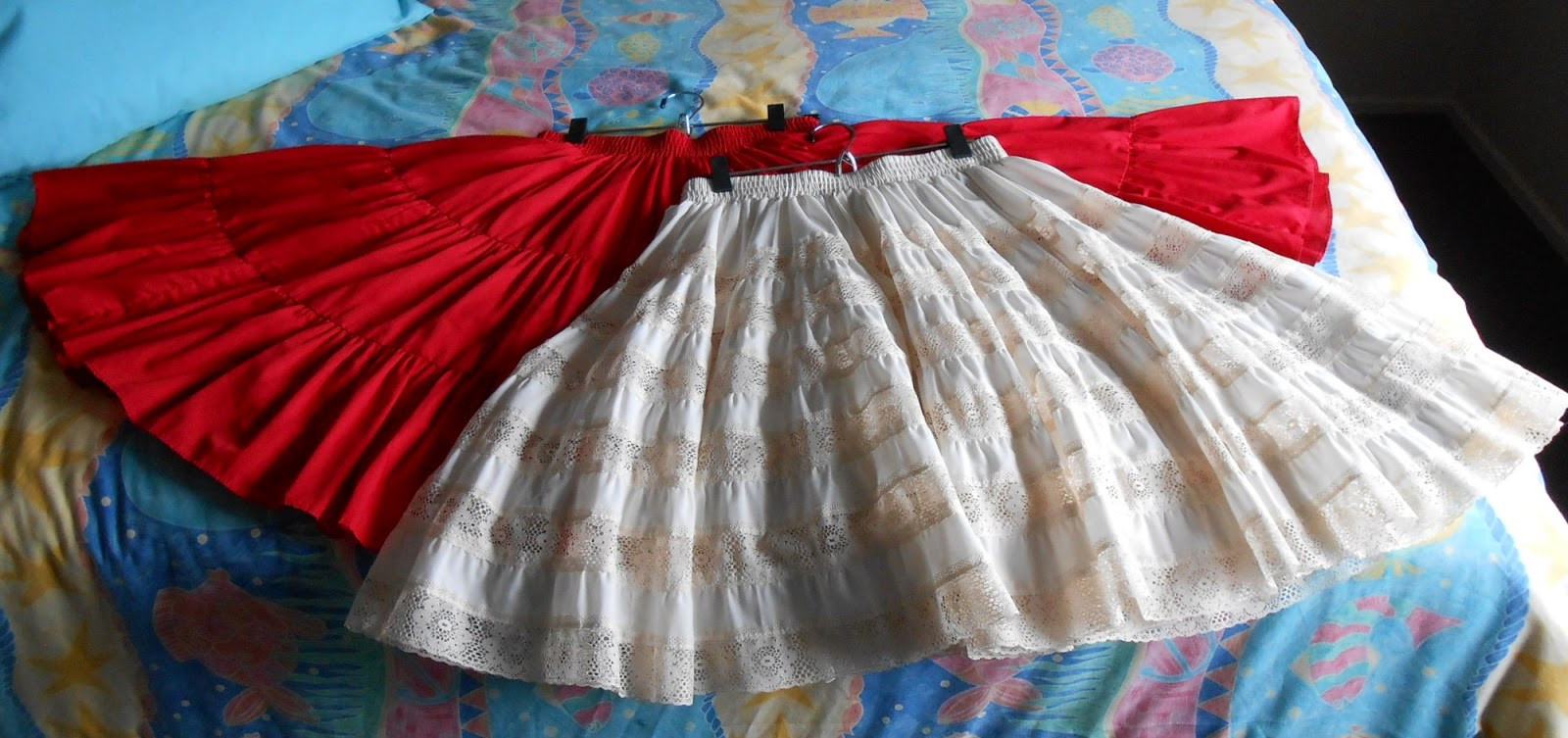 USA-made full circle skirts, showcasing fabric and style variations
USA-made full circle skirts, showcasing fabric and style variations
Image: Two USA-made full circle skirts, demonstrating different fabric choices and design elements in square dance skirts.
Theme Nights: Adding Fun and Flair
Theme nights at square dance conventions offer a chance to break from strict dress codes and inject extra fun into your attire.
- Footwear Remains Formal: Even on theme nights, the primary formality that usually remains is the requirement for suitable dance footwear.
- Creative Costumes: Theme nights encourage creativity and costumes related to the chosen theme.
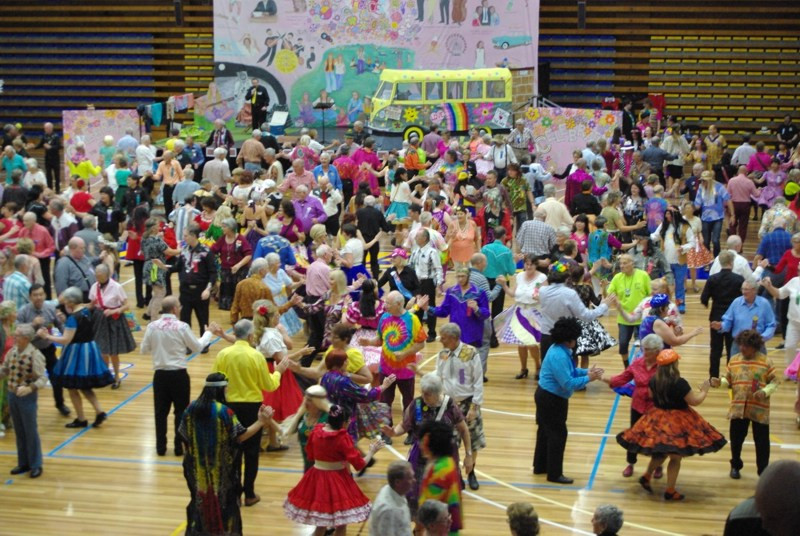 Dancers at a 60s theme night square dance event
Dancers at a 60s theme night square dance event
Image: Dancers participating in a 60s theme night at a square dance convention, showcasing themed costumes.
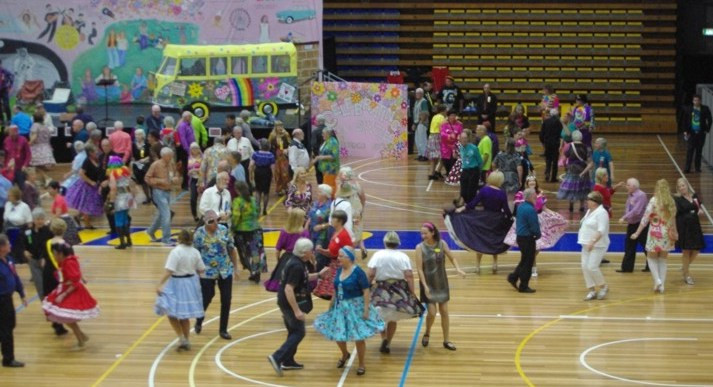 Close-up of dancers in 60s themed square dance attire
Close-up of dancers in 60s themed square dance attire
Image: A closer view of 60s theme costumes, illustrating the creativity and fun of theme night square dance apparel.
Conclusion: Dress with Confidence and Enjoy the Dance
Choosing the right square dance apparel is about finding the balance between comfort, style, and event appropriateness. Whether you prefer casual jeans and a t-shirt for classes or love to dress up in traditional square dance attire for conventions, the most important thing is to feel comfortable and confident so you can fully enjoy the fun, social, and energetic world of square dancing. Remember to always check for specific dress code guidelines, especially for conventions, and let your personal style shine through as you twirl and do-si-do!

